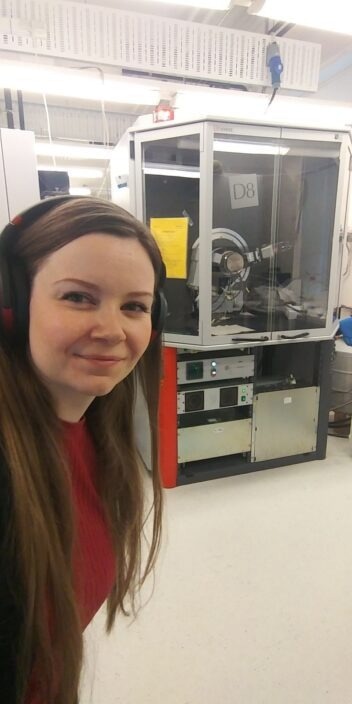Reviewed by Lexie CornerJun 3 2024
In a recently published article in the journal Chemistry of Materials, researchers from the Norwegian University of Science and Technology found a new method to produce clean oxygen using Hexagonal Manganites.

Frida Hemstad Danmo in the lab. This is the instrument the researchers used to make the first kinetic measurements for oxygen uptake. It is called an X-Ray diffractometer. Image Credit: Frida Hemstad Danmo
New materials that produce oxygen may challenge conventional manufacturing techniques. This is great news since there is a growing need for pure oxygen in industry and medicine.
We have identified materials that can store and release pure oxygen much faster and at much lower temperatures than known materials currently used for this purpose.
Sverre Magnus Selbach, Professor, Department of Materials Science and Engineering, Norwegian University of Science and Technology
Since oxygen is an element, it can only be emitted, not created. Although it can also be collected from materials that have oxygen bonded to them, the most popular approach is directly distilling oxygen from the air.
Retrieving Oxygen from Materials
Many materials absorb oxygen from the air. This oxygen is released as these materials heat up, and even small alterations to the materials can alter their characteristics.
Scientists describe a material's “kinetics being faster” when the chemical process quickens or speeds up.
One major benefit is that this method can operate at low temperatures. This means that less energy is needed for heating and that cheaper materials can be used to build reactors, requiring less maintenance than if they were subjected to greater temperatures.
Both of these improvements in material properties make the materials more competitive.
Frida Hemstad Danmo, Ph.D. Candidate, Norwegian University of Science and Technology
The Wonder Material
Hexagonal manganites are a relatively unknown material. In addition to being highly effective in extracting oxygen, the substance is also relatively cheap to produce.
Danmo added, “Because oxygen is absorbed so quickly into the material, we can use bulk materials that can be made in large quantities using cheaper methods than those required to make nanoparticles.”
Nanoparticles would have provided a “shorter way” for oxygen to enter and exit the material, which would have increased surface area if the oxygen transport in these hexagonal manganites had not previously been so quick.
Compared to bulk material, nanoparticles are more difficult to make, particularly in large quantities.
Impurities in the Material are Unproblematic
The hexagonal manganites they have created are “high-entropy materials," meaning they are neither pure nor have a particularly well-ordered crystal structure.
The materials are not only very affordable, but their chemical makeup is also not very important. Therefore, the material's impurities and minor flaws are not an issue. The procedure functions without requiring extreme precision, enabling more affordable production on an industrial scale.
When the researchers included five to six distinct rare earth metals in their mixture, the outcome was far better than when they employed well-ordered materials containing only one or two rare earth metals.
Selbach added, “The high-entropy materials are actually more stable than those with simpler chemical composition. The reason is the entropy, i.e., the disorder that comes from having many different elements in the crystal structure instead of fewer.”
Disorder is the Natural State
Danmo further stated, “All spontaneous processes will increase the disorder of the universe. Interestingly, it is the disorder itself that also provides such rapid oxygen absorption since our materials are not sensitive to precise chemical composition. Focusing on high entropy is a paradigm shift for this particular class of materials and something that has given us exceptional properties.”
Using Cheaper and Available Materials
Although the industry does not currently employ these materials, a lot of research is being done on them because of the enormous potential for producing oxygen at a lower cost.
Selbach further added, “Industry can use cheaper raw materials, such as oxides of recycled rare earth metals or low-quality ore. These raw materials remain after more expensive elements such as neodymium and dysprosium are extracted for use in electric motors in windmills and electric cars.”
Industry may even be able to employ waste materials generated during the production of electric motors.
Aamund Westermoen, in partnership with Danmo, did most of the experimental work. Senior Engineer Elvia Anabela Chavez Panduro contributed measurements at NTNU, and Kenneth Marshall and Dragos Stoian from the European Synchrotron Radiation Facility (ESRF) in France assisted with synchrotron measurements taken at the Swiss-Norwegian Beamlines facility in Grenoble. Frida Hemstad Danmo now works for Norsk Hydro.
Journal Reference:
Danmo, HF., et al. (2024) High-Entropy Hexagonal Manganites for Fast Oxygen Absorption and Release. Chemistry of Materials. doi:10.1021/acs.chemmater.3c02702